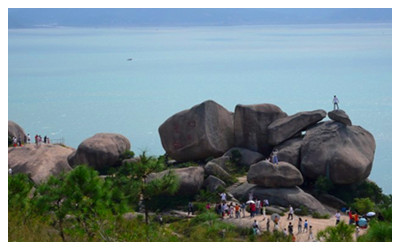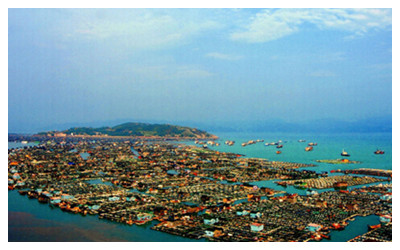Skype: neodalle-travel
Tel: +86 135 7447 2266
E-mail: sales@visitaroundchina.com
 Sandu Bay or Sansha Bay, is situated in the Jiaocheng District of Ningde City, Fujian Province. Being an important maritime gateway in East Fujian, the bay boasts unique natural condition with an only 2.6-kilometer-wide outlet to the sea and a large inner space of 714 sq. km.Closed in on three sides by mountains, the bay is deep and calm, and never gets frozen or silted. The more-than-10-meter deep area reaches 174 sq. km. And its main waterway runs from 35 to 125 m deep, enabling 500,000 tonnage ships to move in and out in all weathers. Well known home and abroad, it ranks high among the top harbors in the world in terms of deep-water area and the length of coastline.
Sandu Bay or Sansha Bay, is situated in the Jiaocheng District of Ningde City, Fujian Province. Being an important maritime gateway in East Fujian, the bay boasts unique natural condition with an only 2.6-kilometer-wide outlet to the sea and a large inner space of 714 sq. km.Closed in on three sides by mountains, the bay is deep and calm, and never gets frozen or silted. The more-than-10-meter deep area reaches 174 sq. km. And its main waterway runs from 35 to 125 m deep, enabling 500,000 tonnage ships to move in and out in all weathers. Well known home and abroad, it ranks high among the top harbors in the world in terms of deep-water area and the length of coastline.Sandu Bay has a long history of opening-up. It has been a busy port for foreign trade in China ever since ancient times, developed even before the Tang Dynasty (618-907AD). In 1684, Ningde Taxation Administration was established here, having jurisdiction over nine ports. In 1898, it was designated as a foreign trade port and Fu  Customs was set up in the next May. Later on, 13 countries including the UK, USA, France and Japan, opened 25 business branches and firms on the coast, and Italy even set up its consulate here. The relic sites of the Gothic church, the British convent and the Fu Customs are still in existence, well preserved. By the breakout of the War of Resistance against Japanese Aggression, Sandu Bay had been suppling Mobil oil and other daily necessities to more than half of the Chinese territory. The scenes of groups of fishing boats returning to the habor in the evening and merchants from everywhere gathering together reflected the economic prosperity of Ningde during that period.
Customs was set up in the next May. Later on, 13 countries including the UK, USA, France and Japan, opened 25 business branches and firms on the coast, and Italy even set up its consulate here. The relic sites of the Gothic church, the British convent and the Fu Customs are still in existence, well preserved. By the breakout of the War of Resistance against Japanese Aggression, Sandu Bay had been suppling Mobil oil and other daily necessities to more than half of the Chinese territory. The scenes of groups of fishing boats returning to the habor in the evening and merchants from everywhere gathering together reflected the economic prosperity of Ningde during that period.
Sandu Bay is a natural spawning field for large yellow croakers. Guanjingyang used to be one of the four largest fisheries in the country. In recent years, net cage breeding has been developing rapidly. Thousands of connected net cages create a spectacular view on the sea, earning a name the “Oriental Venice”. There are now more than 120,000 net cages, farming 20 plus valuable species, such as large yellow croaker, porgy, redfish and abalone. Consequently, Sandu Bay is awarded the title of “model destination for agro-tourism in China” by the National Tourism Administration.
Sandu Bay also boasts many scenic views. Most tourist attractions cluster together at the southeast of the bay. They include the five islets, Sandu, Qingshan, Doumao, Jiongshan and Baipao, the Cheng’ao peninsula and the neighboring sea areas, covering about 80 sq. km. The ocean, the islets, beautiful reefs, the fish rafts and the quays form such an impressive picture that one would naturally accept it as a “heavenly lake” or a “celestial bay.”
Travel Tips
Add:in the Jiaocheng District of Ningde City, Fujian Province.
Entrance Fees: CNY 40
Opening Hours: 08:00-18:00
 Ask Questions ?
Ask Questions ?